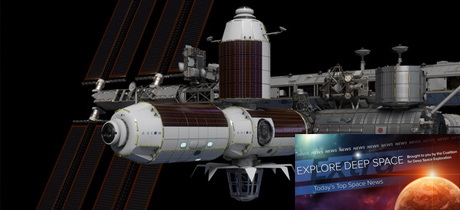In Today’s Deep Space Extra… As it strives to shift its human exploration focus to deep space, NASA is also faced with the challenge of maintaining a low Earth orbit human presence with commercial oversight, a transition that if executed with patience could mean economic growth as well as advances in technology and science.
Human Space Exploration
Koerner new head of Orion program for NASA
Coalition Member in the News – Lockheed Martin
Spacepolicyonline.com (9/8): Widely experienced in human spaceflight and robotic missions over three decades, Catherine Koerner was announced Tuesday as the new director of NASA’s Orion program, the spacecraft that is to launch and return human explorers launched on deep space missions. She succeeds Mark Kirasich, now acting head of the NASA Human Exploration and Operations Mission Directorate’s (HEOMD) Advanced Exploration Systems Division. Orion’s first mission is to help return human explorers to the surface of the Moon in 2024.
Gerstenmaier warns against ending Space Station program prematurely
SpaceNews.com (9/8): Bill Gerstenmaier, NASA’s former associate administrator for Human Exploration and Operations, urged an American Institute of Aeronautics and Astronautics (AIAA) audience on September 5 not to end International Space Station (ISS) operations prematurely. NASA is currently planning how to transition the agency’s oversight of the orbiting lab and low Earth orbit research and technology development to the commercial sector. Gerstenmaier retired from NASA in late 2019 and in February became a consultant to SpaceX.
Making the transition from the ISS
Coalition Member in the News – Axiom Space
The Space Review (9/8): November 2 will mark a significant International Space Station (ISS) milestone, 20 years of a continuous human presence. What’s not clear is how long human occupation will continue. NASA’s presence is authorized by Congress through 2024, and the agency is looking to transition oversight of low Earth orbit human activities to the private sector in order to focus on a human return to the Moon and future exploration of Mars. In that vein, NASA supports plans by Axiom Space to soon equip the Station with a suite of commercial modules. However, a bid to support the development of a commercial space station like free flyer by NASA has been placed on hold. Agency officials have emphasized though that NASA intends to maintain a low Earth orbit presence, a goal best accomplished as one of many tenants of commercial space platforms.
4 Indian astronauts are training in Russia for future spaceflights
Space.com (9/8): India has four astronauts training in Russia as part of India’s crewed Gaganyaan project. The training will continue into early 2021. A requirement for the Gaganyaan project is that they launch on an Indian rocket. So far, two Indians have launched, one on a NASA mission, the other with Russia’s space agency.
Space Science
NASA issues new call for lunar payload deliveries from its commercial Moon lander partners
Coalition Members in the News – Astrobotic, Lockheed Martin
Techcrunch.com (9/8): NASA has called on its 14 Commercial Lunar Payload Services (CLPS) partners to bid on launching and landing 10 new science experiments and technology demonstrations to the Moon in 2022 to support plans to return to the lunar surface with human explorers in 2024. A launch provider for what will be the initiative’s fifth mission, the first of them to launch in June 2021, is to be selected by year’s end.
3,200 megapixels! The camera heart of future Vera Rubin Observatory snaps record-breaking 1st photos
Space.com (9/8): The camera for the Vera Rubin Observatory, a telescope observatory under construction in the Chilean Andes, took the largest single digital image ever while at the Department of Energy’s Stanford Linear Accelerator Laboratory. Testing has demonstrated a resolution that could image a golf ball from a distance of 15 miles.
Extraterrestrial hunters figure out a way to expand their search for signals by a factor of 200
Universe Today (9/7): Breakthrough Listen, a 10 year international effort to search for extraterrestrial Intelligence funded by the Russian/American billionaire Yuri Milner, now has a new analytical tool. The tool promises to expand the search effort by 200 times to now include more than 288,000 stars as far as 33,000 light years away.
Op Eds
The future on hold: America’s need to redefine its space paradigm
The Space Review (9/8): This op-ed argues that the U.S. Gross Domestic Product has failed to grow as much as it could have in the post Apollo era due to a lack of investment and incentive within the transportation, manufacturing and energy sectors and too much on information and communications. The space enterprise could serve as a focus to re-energize significant economic growth, suggests author Stephen Kostes, a New York area business and economic instructor and retired IBM senior manager.

